The transmission of malaria from man to man is done by the female anopheles mosquito. This vector is one of the commonest vectors transmitting human diseases with varrying species as they are scattered across the globe. Other diseases transmitted by the mosquito include Timorese filaria, W. bancroft, Brugia timori among others.
HOW DOES MOSQUITO FEED
The female mosquito pierce through the skin of its host, using a part of its proboscis. With the proboscis, a penetration into the tiny blood vessels is done and if penetration into the blood vessel fails, the mosquito pulls back and refits the proboscis through the same skin hole. The mosquito systematically uses the hollow in the first hollow tube in the proboscis to withdraw blood from the vessel and the second to inject saliva into the microscopic wound. This saliva constitutes anti hemostatic and antiinflammatory enzymes that impedes the clotting process thereby inhibiting the pain reaction. This is done so as to make the victim unaware of the bite.

MEASURES AGAINST MALARIA TRANSMISSION
Appropriate body cover
The most preventive measure is to avoid their bites. In this case, the use of the insecticide treated nets and full body-covering clothes should be considered.
Discouragement of mosquito hideouts
Mosquitoes are haboured in a room where clothes are carelessly hung. Dark places and the spots with a low human use should be kept clean and looked into from time to time for a mosquito check.
Insecticide use
The use of insecticide should be encouraged.
When using insecticides, care must be taken lest we ourselves inhale the substance.
Biological control
Anophele mosquitoes breed in water-collected places which may include ponds, waterlogged drainage, bucket containing water among others. Efforts should be made to discourage them from breeding.
Words from healthgist.net
It is highly recommended that Physicians or Pharmacist are consulted in case of symptoms for proper diagnosis and treatments.
Source:
Malaria site
Wikipedia

He is a graduate of Obafemi Awolowo University (OAU), Ile-Ife, Osun State, Nigeria.
Yomi Adeyemo is an educationist whose passion lies in enlightening the society- making the unknown known. His hobbies are reading, writing and being around people.

